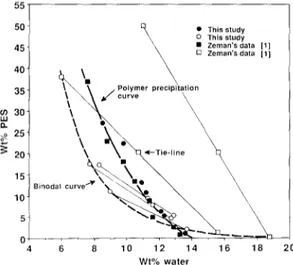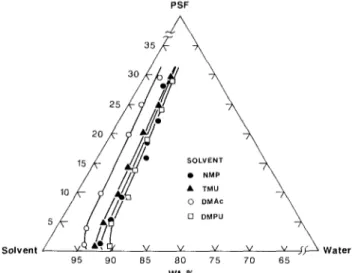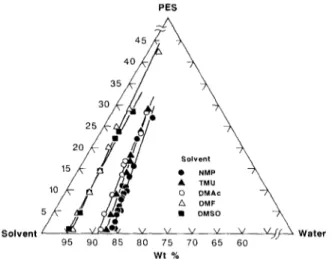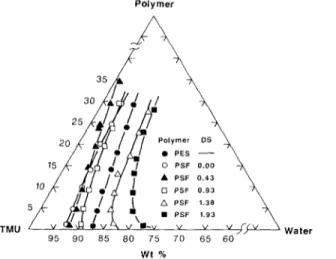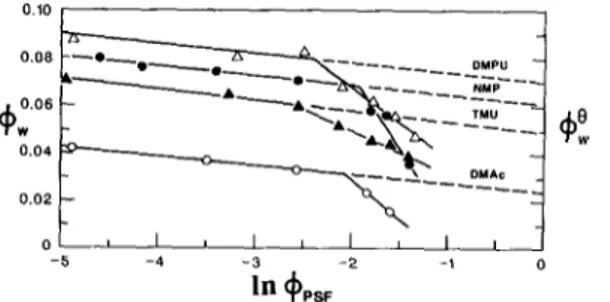Publisher’s version / Version de l'éditeur:
Journal of Membrane Science, 59, 1991
READ THESE TERMS AND CONDITIONS CAREFULLY BEFORE USING THIS WEBSITE.
https://nrc-publications.canada.ca/eng/copyright
Vous avez des questions? Nous pouvons vous aider. Pour communiquer directement avec un auteur, consultez la première page de la revue dans laquelle son article a été publié afin de trouver ses coordonnées. Si vous n’arrivez pas à les repérer, communiquez avec nous à PublicationsArchive-ArchivesPublications@nrc-cnrc.gc.ca.
Questions? Contact the NRC Publications Archive team at
PublicationsArchive-ArchivesPublications@nrc-cnrc.gc.ca. If you wish to email the authors directly, please see the first page of the publication for their contact information.
NRC Publications Archive
Archives des publications du CNRC
This publication could be one of several versions: author’s original, accepted manuscript or the publisher’s version. / La version de cette publication peut être l’une des suivantes : la version prépublication de l’auteur, la version acceptée du manuscrit ou la version de l’éditeur.
Access and use of this website and the material on it are subject to the Terms and Conditions set forth at
Phase separation in polysulfone/solvent/water and
polyethersulfone/solvent/water systems
Lau, Wai-Hung; Guiver, Michael; Matsuura, T.
https://publications-cnrc.canada.ca/fra/droits
L’accès à ce site Web et l’utilisation de son contenu sont assujettis aux conditions présentées dans le site LISEZ CES CONDITIONS ATTENTIVEMENT AVANT D’UTILISER CE SITE WEB.
NRC Publications Record / Notice d'Archives des publications de CNRC:
https://nrc-publications.canada.ca/eng/view/object/?id=2913a4fc-2390-4d58-9221-914538c6a1f2 https://publications-cnrc.canada.ca/fra/voir/objet/?id=2913a4fc-2390-4d58-9221-914538c6a1f2Journal of Membrane Science, 59 zyxwvutsrqponmlkjihgfedcbaZYXWVUTSRQPONMLKJIHGFEDCBA(1991) 219-227
Elsevier Science Publishers B.V.. Amsterdam
219 zyxwvutsrqponmlkjihgfedcbaZYXWVUTSRQPONMLKJIHGFEDCBA
Phase separation in polysulfone/solvent/water
and
polyethersulfone/solvent/water
systems*
Wayne W.Y. Lau
Department of Chemical Engineering, National University of Singapore (Singapore)
Michael D. Guiver** and T. Matsuura
Institute for Environmental Chemistry, National Research Council, Ottawa, Ont. KlA OR6 (Canada)
Abstract
Polymer precipitation curves for the ternary systems polysulfone/solvent/water and poly- ethersulfone/solvent/water were determined by a titration method. Membrane forming solvents used were NMP, DMAc, DMF, DMSO, TMU and DMPU. Solvent/water theta-compositions were also estimated. Tie-line data for PES/NMP/H20 system are presented, from which its bin- odal curve can be constructed.
Keywords: polymer precipitation curves; polysulfone membrane; polyethersulfone membrane;
membrane preparation zyxwvutsrqponmlkjihgfedcbaZYXWVUTSRQPONMLKJIHGFEDCBA
Introduction
Polyethersulfone (PES ) ( 1) and polysulfone (PSf) (2 ) are widely used
(I)
ultrafiltration and microfiltration membrane materials. PES is more hydro- phylic while PSf is relatively hydrophobic. PES (T,= 225” C) also has higher thermal stability than PSf ( Tg = 190 o C ) . Thus PES appears to be a more ver- satile membrane material than is PSf.
PES and PSf membranes are usually made by the phase inversion technique
*NRC No. 32539
**TO whom correspondence should be addressed.
220 zyxwvutsrqponmlkjihgfedcbaZYXWVUTSRQPONMLKJIHGFEDCBA
by precipitating a cast polymer solution with a non-solvent, normally water. The quench step in this membrane forming process bears close similarities with a process in which a polymer solution is titrated with a non-solvent until persistent visual turbidity is observed.
Several authors referred to a curve formed by joining these turbidity points (titration endpoints) as a cloud point curve [l-3], while other referred to a binodal curve in liquid-liquid phase separation also as a cloud point curve [ 41. To avoid possible confusion, in this paper we refer to a curve obtained by join- ing titration end-points in liquid-solid phase separation as a polymer precipi- tation curve, and one defined by tie-line compositions in liquid-liquid phase separation as a binodal curve.
Polymer precipitation curves in the form of a ternary phase diagram can provide useful thermodynamic and kinetic information on membrane making processes. Precipitation curves of PSf/ DMF/ H,O [ 251, PSf/ DMAc/ H,O
[ 6,7], PSf/ NMP/ H,O [ 21, PES/ NMP/ H20 [ 1,8] and PES/ H,O with DMF, NMP and DMSO [2] systems have been reported. In this paper we present precipitation point data of PES and PSf in six membrane forming solvents using water as the non-solvent. Comparison between these two sets of data is made. The theta-compositions of water/ solvent mixtures were also estimated. Tie-line data for the PES/ NMP/ H,O system were also collected, from which its binodal curve can be constructed.
Experimental zyxwvutsrqponmlkjihgfedcbaZYXWVUTSRQPONMLKJIHGFEDCBA
Materials
Udel@ P-3500 polysulfone from Amoco Performance Products and Victrex@ 200P polyethersulfone from I.C.I. PLC were dissolved at various concentra- tions at 25°C in the following solvents: N-methyl-2-pyrrolidinone (NMP) and dimethylformamide (DMF ) from Anachemia Ltd. (both were distilled under vacuum before use ) ; dimethylacetamide (DMAc ) containing 0.001% water and dimethylsulfoxide (DMSO) containing 0.002% water (both from T. Baker Chemical Co.); tetramethylurea (TMU) from Sigma Chemical Co.; and NJ- dimethylpropyleneurea (DMPU) from Aldrich Chemical Co. The last four sol- vents were used as supplied. Distilled water was the non-solvent.
Polymer precipitation curve
Polymer precipitation curves were obtained by a simple titration method as was used by Swinyard et al. [ 21, in which polymer solutions at various concen- trations were titrated with distilled water at 25°C in 50 ml Erlenmeyer flasks for polymer concentrations not higher than 10 wt.%, and in 5 ml sample bottles stirred by a stainless steel rod through a rubber septum stopper for higher polymer concentrations. Mixing in the higher concentration samples was fa-
221 zyxwvutsrqponmlkjihgfedcbaZYXWVUTSRQPONMLKJIHGFEDCBA cilitated by warming the isolated sample bottles in a thermobath at 50” C. De-
tail of this simple titration method is given elsewhere zyxwvutsrqponmlkjihgfedcbaZYXWVUTSRQPONMLKJIHGFEDCBA[ 91. Tie-line
Tie-line data were collected as follows: aliquots of a PES/NMP/H,O mix- ture at its precipitation point composition were placed in septum sealed test tubes which were kept at 25’ C in a thermostatted bath for over a month. Two clear liquid layers developed which can be assumed to have reached equilibrium state. From one tube the less viscous top layer was withdrawn with a syringe. This mixture was distilled under vacuum and the distillate was collected in a liquid nitrogen cold trap. Water content in this NMP/H*O mixture was deter- mined by the Karl-Fisher method. From another tube both the top and bottom layers were removed separately and placed in petri dishes. These samples were dried in a vacuum oven for one week until constant weight of the polymer residue was observed. Tie-line compositions were then calculated through ma- terial balance.
Results and discussion
Binodal curve of PES/NMPIH,O system
Zeman et al., in their thermodynamic analysis of the PES/NMP/H,O sys- tem [ 11, presented precipitation point data and two tie-lines of this system. Our experimental results, together with theirs, are plotted in a right-angled triangular plot in Fig. 1. Good agreement is seen between these two sets of data. Five tie-lines are presented in Fig. 1, from which the binodal curve for
PES/NMP/H,O system is constructed. It covers a range of PES concentra- zyxwvutsrqponmlkjihgfedcbaZYXWVUTSRQPONMLKJIHGFEDCBA
55
I
-4 6 8 10 12 14 16 18 20 wwo water
222
tions useful to membrane casting operations. For example, this binodal curve marks the upper limit below which stable PES/NMP/H,O systems can exist in one homogenous liquid phase. For membrane cast from a ternary dope, it is preferable that the composition of the dope lies below the binodal. PES mem- branes are usually cast from solutions containing 20-25 wt.% polymer. At this PES concentration, a stable ternary PES/NMP/H,O dope would contain 7- 7.5 wt.% water.
In the water quench step of a membrane casting operation, polymer precip- itation in the presence of an excess of quench water takes place almost instan- taneously. This process is irreversible in the presence of excess water. In the titration of a PES/NMP or PSf/NMP solution with water, polymer precipi- tation occurs when sufficient water is added. Since the amount of water added in our experiment was not in excess, the polymer precipitates slowly redis- solved upon standing in a controlled environment and distributed in two clear liquid phases. Compositions of these conjugative liquid phases at equilibrium define the binodal curve of the ternary system. While a binodal curve provides useful thermodynamic information, for example, for the preparation of a cast- ing solution, a polymer precipitation curve provides information more relevant to membrane casting by the phase inversion process.
Precipitation point curves of PES and PSf in six solvent/water mixtures are presented in Figs. 2 and 3. PES is soluble in five of the six solvents; it slowly forms a gel with DMPU. PSf is soluble in four of the solvents but is only spar- ingly soluble in the other two solvents, DMSO and DMF. The liquid homoge- neous region lies mainly in the space between the polymer/solvent axis and
the precipitation curve. The width of this region is an indication of the system’s zyxwvutsrqponmlkjihgfedcbaZYXWVUTSRQPONMLKJIHGFEDCBA
PSF
95 90 65 60 75 70 65 wt %
223
PES
Solvent
95 so 85 80 75 70 65 60
Fig. 3. Polymer precipitation curves of PES/H,O with various solvents at 25°C.
tolerance for water before polymer precipitation occurs. The widest region for PES was obtained with NMP and for PSf with DMPU. This upper limit of water tolerance in the PSf/NMP/H20 system lies between 5 and 10 wt.% water while that for PES/NMP/H,O system lies between 10 and 14 wt.% water. Thus PES is more soluble in NMP/H20 mixture than is PSI. The width of these miscibility regions indicate that the solvent dissolution power for PES ranks NMP> TMU>DMAc>DMSO>DMF, and for PSf they rank DMPU>NMP>TMU>DMAc.
This miscibility region can also be considered a measure of the system’s resistance to polymer precipitation by the non-solvent. In a membrane forming process by the phase inversion method, the size of this region reflects the amount of non-solvent to be imbided by the polymer in the quench step. Kai et al. [lo]
cast membranes for PES/NMP/H,O and PSf/NMP/HBO dopes and reported that the amount of water imbided in the water quench step appeared to have a significant influence on the pore structure in the top skin layer of the mem- brane. They measured the amount of water required to turn a 2% polymer solution (binary dope or ternary dope) turbid and called it the coagulation value CV. They evaluated the membranes using pure water and 0.2% aqueous ovalbumin as a solute. It was found that pure water flux (PWF) decreased with increase in CV, an indication that the amount of imbided water influenced the polymer morphology in the resulting membrane. Pore structure in a mem- brane is influenced by both thermodynamic and kinetic factors of the casting system and the casting process, which include, of course, polymer conforma- tion just before the polymer is precipitated by ingress of non-solvent in the quench step.
224 zyxwvutsrqponmlkjihgfedcbaZYXWVUTSRQPONMLKJIHGFEDCBA Hydrophilic and hydrophobic nature of polymers
The miscibility regions (Figs. 2 and 3 ) from our polymer precipitation data are also indicators of the degree of tolerance for wat.er by PES and PSf to co- exist in the ternary system in one liquid phase. They also indicate the capacity of the polymers to associate with water while in solution. Figures 2 and 3 clearly show that PES is more hydrophilic than PSf. This fact is also observed in water sorption experiment [ 111 in which PSf in powder form was found to absorb 1% of its own weight of water from a water vapour saturated environment, from which a carboxylated PSf with two -COOH groups per repeat unit was able to absorb over 10 wt.% water. Singh et al. [12] reported that PES ab- sorbed 2.3 wt. % water at 30’ C. These experimental results show that this car- boxylated P:3f is substantially more hydrophilic than PES.
Polymer precipitation curves of carboxylated PSf with 0.43,0.93, 1.38, 1.93 -COOH groups per repeat unit have been determined for these same solvent/ water systems [ 91. When the precipitation curve of PES is placed in the same ternary phase diagram with those of the carboxylated PSf, it always occupies a median position among the other curves. An example is shown in Fig. 4 in which the position of the precipitation curves shows the polymer’s capacity to absorb water.
Water/solvent theta-composition
When a non-solvent is added to a polymer solution the polymer dissolving power of the solvent is reduced by the non-solvent. In titrating a polymer so- lution using water as the non-solvent, somewhere along the path leading from the initial starting point up to near the precipitation point, a stage would be
Polymer . PES - 0 PSF 0.00 A PSF 0.43 0 PSF 0.93 a PSF 1.38 . PSF 1.93 TMU water 95 90 85 80 75 70 65 60
Fig. 4. Polymer precipitation curves of PES/TMU/H,O and carboxylated PSf/TMU/HZO at 25°C.
225
Fig. 5. Volume fraction of water @, vs. log Q, rsr, volume fraction of PSf at the polymer precipitation point.
0 ~‘I~~“~~‘~(~‘~~~“‘~
-5 -4
In
&,, -2 -’ O
Fig. 6. Volume fraction of water $J, vs. log &ss, volume fraction of PES at the polymer precipi- tation point.
TABLE zyxwvutsrqponmlkjihgfedcbaZYXWVUTSRQPONMLKJIHGFEDCBA1
Volume fraction di of water/solvent mixtures at theta-conditions for PES and PSf
Solvent system DMPU NMP TMU DMAc DMSO DMF
Water
-ratio for PSf - 0.071 - 0.061 0.049 - 0.024 __ - -
Solvent 0.929 0.939 0.951 0.976
Water -
___ ratio for PES 0.110 0.090 0.074 0.037 0.031
Solvent 0.890 0.910 0.926 0.963 0.969
reached in which the solvent/non-solvent mixture becomes a theta-solvent for the polymer, and the macromolecules in it would assume an unperturbed con- formation. This theta-composition can be determined by the method of Elias
[13] using precipitation point data. In this method the concentration of the non-solvent C,,, at a precipitation point is plotted against the corresponding polymer concentration, C, in a form log [ C,,] =f(log [ C,,] ). The theta-compo- sition of the non-solvent, (2% is obtained by extrapolating the plot to 100%
226 zyxwvutsrqponmlkjihgfedcbaZYXWVUTSRQPONMLKJIHGFEDCBA
polymer. Park et al. [ 31, in their study on the conformational characteristics of PES in DMF/methanol and DMF/toluene mixed solvents, plotted the vol- ume fraction of the non-solvent, &, versus the volume fraction of the polymer, &,, at the precipitation point to obtain &upon extrapolation to 100% polymer. Precipitation point data for PSf and PES in the present study were treated according to the method of Park as shown in Figs. 5 and 6 respectively, in which #i are volume fractions. Component volumes were calculated by dividing mass by density, and volume fractions were obtained on the assumption that com- ponent volumes are additive. Estimated theta-compositions are summarized in Table 1.
Since density of the solvents is close to that of water, volume fractions in Table 1 correspond closely to weight fractions in the ternary systems. With reference to Figs. 2 and 3 it can be seen that @, weight fractions lie very close to the precipitation point, in fact only 2 to 3 wt.% away from the binodal com- position. Ternary dopes of these theta-composition would definitely ingress much less water in the quench step than does a binary polymer/solvent solu- tion. Based on the findings of Kai [lo] dopes at the theta-condition should
give membranes with pore structure more favourable to higher PWF. zyxwvutsrqponmlkjihgfedcbaZYXWVUTSRQPONMLKJIHGFEDCBA
Conclusions
Polymer precipitation curves of polysulfone (PSf) and polyethersulfone (PES) in six membrane forming solvents were obtained using water as the non-solvent. A binodal curve for the system PES/NMP/H,O was constructed from tie-line data. Theta-compositions of these solvent water mixtures for PSf and PES were estimated.
Acknowledgements
W.W.Y. Lau wishes to acknowledge the support for this study from the In- stitute for Environmental Chemistry of the National Research Council Can- ada, and a Sabbatical travel grant from the National University of Singapore,
References
L. Zeman and L. Tkacik, Thermodynamic analysis of a membrane-forming system water/ IV-methyl-2-pyrrolidone/polyethersulfone, J. Membrane Sci., 36 (1988) 119.
B.T. Swinyard and J.A. Barrie, Phase separation in non-solvent/dimethylformamide/po- lyethersulfone and non-solvent/dimethylformamide/polysulfone, Brit. Polym. J., 20 (1988) 317.
Y.H. Park and DC. Lee, Conformational characteristics of poly(diphenylethersulfone) de- termined in mixed solvents under theta-condition, Polymer (Korea), 12 (8) (1988) 749; Chem. Abstr., llO(18): 155120~.
227 zyxwvutsrqponmlkjihgfedcbaZYXWVUTSRQPONMLKJIHGFEDCBA
4 zyxwvutsrqponmlkjihgfedcbaZYXWVUTSRQPONMLKJIHGFEDCBAR. Koningsveld and A.J. Staverman, Liquid-liquid phase separation in multicomponent polymer solutions. III. Cloud-point curves, J. Polym. Sci., Part A-2,6 (1968) 305.
5 L. Broens, F.W. Altena, C.A. Smolders and M. Koenhen, Asymmetric membrane structures as a result of phase separation phenomena, Desalination, 32 (1980) 33.
6 J.G. Wijmans, J. Kant, M.H.V. Mulder and C.A. Smolders, Phase separation phenomena in solutions of polysulfone in mixtures of a solvent and a nonsolvent: relationship with mem- brane formation, Polymer, 26 (1988) 1539.
7 G.E. Gaides and A.J. McHugh, Gelation in an amorphous polymer: a discussion of its relation to membrane formation, Polymer, 30 (1989) 2118.
8 G. Tkacik and L. Zeman, Component mobility analysis in the membrane-forming system water/N-methyl-2-pyrrolidone/polyethersulfone, J. Membrane Sci., 31 (1987) 273. 9 W.W.Y. Lau, M.D. Guiver and T. Matsuura, Phase separation in carboxylated polysulfone/
solvent/water systems, J. Appl. Polym. Sci., in press.
10 M. Kai, K. Ishii, H. Tsugaya and T. Miyano, Development of polyethersulfone ultrafiltration membranes, in: T. Matsuura and S. Sourirajan (Eds.), Reverse Osmosis and Ultrafiltration, ACS Symposium Series No. 281, American Chemical Society, Washington, DC, 1985, Chap. 2, pp. 21-33.
11 M.D. Guiver, S. Croteau, J.D. Hazlett and 0. Kutowy, Synthesis and characterization of carboxylated polysulfones, Brit. Polym. J., 23 (1990) 29.
12 V.B. Singh, J.A. Barrie and D.J. Walsh, Sorption of water in polyethersulfone/poly (ethylene oxide) blends, J. Appl. Polym. Sci., 31 (1986) 295.
13 H.G. Elias, The constitution and solution properties of macromolecules. I. Critical miscibil- ities and solvents, Macromol. Chem., 50 (1961) 1.
